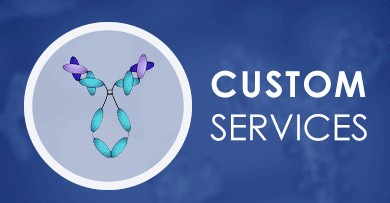 Loading...
Loading...

NXF1
 Loading...
Loading...Anti-NXF1 Products
-
- Species Reactivity: Human
- Type: Rabbit IgG
- Application: WB, IF, IP
-
- Derivation: Rabbit
- Species Reactivity: Human
- Type: Rabbit IgG
- Application: WB, ELISA
-
- Species Reactivity: Human
- Type: Rabbit IgG
- Application: WB, IHC-Fr, IHC-P, IF, IP
- AbPlus™ Anti-NXF1 Magnetic Beads (VS-0724-YC331) (VS-0724-YC331)
-
- Target: NXF1
- Target Species: Human
- Application: IP, Protein Purification
-
- Species Reactivity: Human
- Type: Mouse antibody
- Application: ELISA, ICC, IF, IP, WB
-
- Derivation: Phage display library screening
- Species Reactivity: Human
- Type: IgG
- Application: WB, IHC, ICC, IP
- Anti-NXF1 Immunohistochemistry Kit (VS-0325-XY1536)
-
- Species Reactivity: Human, Mouse, Rat
- Target: NXF1
- Application: IHC
Can't find the products you're looking for? Try to filter in the left sidebar.Filter By Tag
Our customer service representatives are available 24 hours a day, from Monday to Sunday. Contact Us
For Research Use Only. Not For Clinical Use.
Background
Transporters
Intracellular
Low cell type specificity
Low immune cell specificity
Low cell line specificity
Heterodimer (via NTF2 domain) with NXT1 (PubMed:11583626). The formation of NXF1-NXT1 heterodimers is required for the NXF1-mediated nuclear mRNA export (PubMed:11583626). Forms a complex with RANBP2/NUP358, NXT1 and RANGAP1 (PubMed:14729961). Associates with the exon junction complex (EJC) and with the transcription/export (TREX) complex (PubMed:11707413, PubMed:22893130). Found in a mRNA complex with UPF3A and UPF3B (PubMed:11546873). Found in a post-splicing complex with RBM8A, UPF1, UPF2, UPF3A, UPF3B and RNPS1 (PubMed:11546874). Interacts (via N-terminus) with DHX9 (via N-terminus); this interaction is direct and negatively regulates NXF1-mediated nuclear export of constitutive transport element (CTE)-containing cellular mRNAs (PubMed:10924507). Interacts with ALYREF/THOC4 (PubMed:11707413, PubMed:14730019, PubMed:19165146, PubMed:23299939). Interacts with FYTTD1/UIF (PubMed:19836239). Interacts with EIF4A3 (PubMed:14730019). Interacts with NUP42 (PubMed:10228171). Interacts with THOC5 (PubMed:19165146, PubMed:23299939). Interacts with CHTOP (PubMed:23299939, PubMed:23826332). Interacts with FRG1 (via N-terminus) (PubMed:21699900). Interacts with LUZP4 (PubMed:25662211). Interacts with FMR1; the interaction occurs in a mRNA-dependent and polyribosomes-independent manner in the nucleus (PubMed:18936162). Interacts with CPSF6 (via N-terminus); this interaction is direct (PubMed:19864460). Interacts with RBM15 (PubMed:17001072). Interacts with RBM15B (PubMed:19586903). Interacts with MCM3AP isoform GANP; this interaction is not mediated by RNA (PubMed:20005110). Interacts with DDX3X (via C-terminus); this interaction may be partly involved in DDX3X nuclear export and in NXF1 localization to stress granules (PubMed:18596238). Interacts with PABPC1/PABP1 (PubMed:18596238). (Microbial infection) Interacts with Saimiriine herpesvirus 2 TIP protein. (Microbial infection) Interacts with human herpes virus 1 (HHV-1) ICP27 protein; this interaction allows efficient export of HHV-1 early and late transcripts. (Microbial infection) Interacts (via RNA-binding domain) with Ebolavirus nucleoprotein; this interaction recruits NXF1 to the inclusion bodies were viral replication takes place, probably to export viral mRNA-NXF1 complexes from these sites.
RNA-binding

